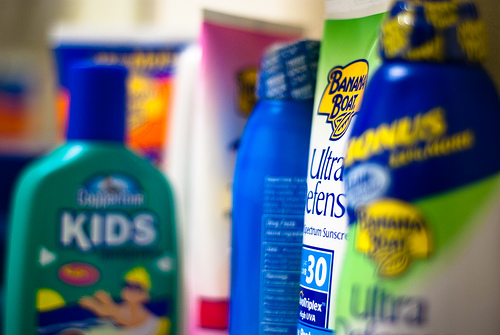Sunscreen: What You Should Know
During summer, we instinctively reach for a swimsuit and sunglasses, but there’s another item that everyone also needs—sunscreen.
We’re lucky to have more than 200 sunny days a year here in Central Florida, but all that sun comes with an added responsibility to protect your skin.
Sunscreen has gotten a lot of attention lately. Congress passed the Sunscreen Innovation Act last year in an attempt to speed the approval of sunscreen ingredients and the City of Boston recently announced it would install 30 sunscreen dispensers at local parks.
Sunscreen is so important because skin cancer is the most common form of cancer diagnosed in the U.S. Sunscreen protects your skin from the sun’s harmful rays, which cause fine lines and wrinkles in addition to skin cancer. But with dozens of products on the market, which one should you choose? Some sunscreens offer better sun protection than others: it’s important to know what to look for.
Understanding SPF
The SPF, or Sun Protection Factor, scale only address ultraviolet B (UVB) rays. These rays cause sunburns and are largely responsible for squamous cell carcinoma. Surprisingly, many sunscreens don’t do a good job of protecting us from ultraviolet A (UVA) rays, which we believe cause wrinkles, basal cell carcinoma, and (potentially lethal) malignant melanoma. It’s frightening but true: some high SPF sunscreens do nothing to protect us from aging and the most serious skin cancers.Choosing a Sunscreen
 Picking the right sunscreen is critical, especially when you live in a climate that’s warm year-round. Unfortunately, the efficacy of many U.S. sunscreens lags behind those offered in other countries because the Food and Drug Administration has not expanded its list of approved sunscreen ingredients since 1999. We hope the FDA will act to approve new sunscreens currently available in other countries, but experience has shown us that this is unlikely to happen anytime soon.
Picking the right sunscreen is critical, especially when you live in a climate that’s warm year-round. Unfortunately, the efficacy of many U.S. sunscreens lags behind those offered in other countries because the Food and Drug Administration has not expanded its list of approved sunscreen ingredients since 1999. We hope the FDA will act to approve new sunscreens currently available in other countries, but experience has shown us that this is unlikely to happen anytime soon.For now, you should do everything possible to minimize sun damage to your skin. Remember that a bottle’s SPF number isn’t really predictive of the kind of sun protection you’ll get. Beware of marketing gimmicks that advertise SPF 100+. The SPF curve approaches 100 percent UVB protection at SPF 30; higher numbers don't afford any meaningful protection. In fact, higher SPF sunscreens are less balanced and less likely to provide broad spectrum UVA-UVB coverage. Finally, avoid spray sunscreens, since they provide poor coverage and are potentially harmful if inhaled.
Instead, wear a broad-spectrum sunscreen that protects against UVA and UVB rays. Natural and chemical-free sunscreens have generated a lot of buzz lately, but any sunscreen with zinc oxide is inherently natural. Dermatologists have recommended sunscreens with this ingredient for years. I love zinc oxide because it provides coverage across the whole spectrum for both UVA and UVB rays. It’s also completely natural and safe—in fact, it’s a main ingredient in baby ointments.
Finally, remember that sunscreen is just one tool in the fight against skin cancer and aging. When you’re having fun outdoors, make sure to wear protective clothing, use an umbrella, and avoid the sun between the peak hours of 10 a.m. to 2 p.m.. Taking all these precautions will minimize sun damage and help your skin stay healthy for a lifetime.







